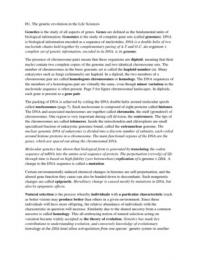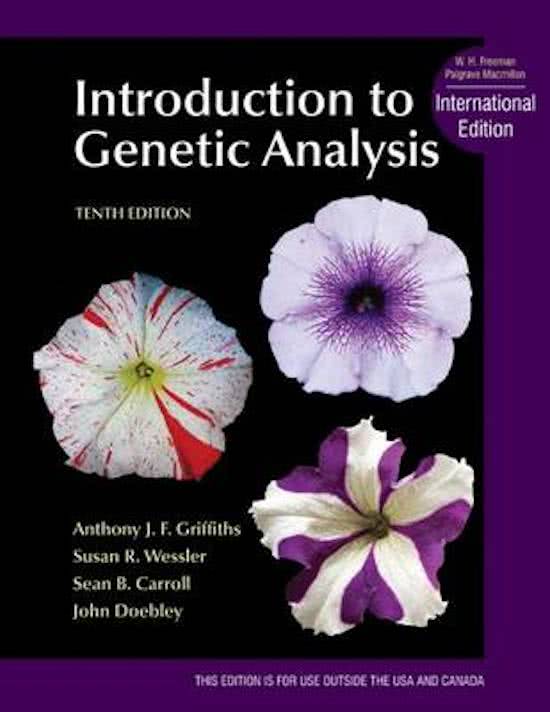H1, The genetic revolution in the Life Sciences
Genetics is the study of all aspects of genes. Genes are defined as the fundamental units of
biological information. Genomics is the study of complete gene sets (called genomes). DNA
is biological information encoded as a sequence of nucleotides. DNA is a double helix of two
nucleotide chains held together by complementary paring of A-T and G-C. An organism’s
complete set of genetic information, encoded in tis DNA, is its genome.
The presence of chromosome pairs means that these organisms are diploid, meaning that their
nuclei contain two complete copies of the genome and two identical chromosome sets. The
number of chromosomes in the basic genomic set is called the haploid number (n). Many
eukaryotes such as fungi (schimmels) are haploid. In a diploid, the two members of a
chromosome pair are called homologous chromosomes or homologs. The DNA sequences of
the members of a homologous pair are virtually the same, even though minor variation in the
nucleotide sequence is often present. Page 5 for figure chromosomal landscapes. In diploids,
each gene is present as a gene pair.
The packing of DNA is achieved by coiling the DNA double helix around molecular spools
called nucleosomes (page 7). Each nucleosome is composed of eight proteins called histones.
The DNA and associated nucleosomes are together called chromatin, the stuff (grondstof) of
chromosomes. One region is very important during cell division, the centromere. The tips of
the chromosomes are called telomeres. Inside the mitochondria and chloroplasts are small
specialized fraction of eukaryotic genomes found, called the extranuclear genome. The
nuclear genomic DNA of eukaryotes is divided into a discrete number of subunits, each coiled
around histone proteins in a chromosome. The main functional regions of the DNA are the
genes, which are spaced out along the chromosomal DNA.
Molecular genetics has shown that biological form is generated by translating the codon
sequence of mRNA into the amino acid sequence of protein. The perpetuation (vervolg) of life
through time is based on high-fidelity (zeer betrouwbare) replication of a genome’s DNA. A
change to the DNA sequence is called a mutation.
Certain environmentally induced chemical changes in histones are self-perpetuation, and the
altered gene function they cause can also be handed down to descendants. Such nongenetic
changes are called epigenetic. Hereditary change is caused mostly by mutations in DNA, but
also by epigenetic effects.
Natural selection is the process whereby individuals with a particular characteristic (such
as better vision) may produce better than others in a given environment. Since these
individuals will have more offspring, the relative abundance of individuals with the
characteristic in question will increase. Similarity due to the shared ancestry from a common
ancestor is called homology. This all-embracing notion of natural selection acting on
variation became widely accepted as the theory of evolution. Genetics has made key
contributions to understanding evolution, and conversely knowledge of evolutionary
homology at the DNA level allow extrapolation from one species’ genetic system to another.
, Y-chromosomal DNA is given trough by the paternal line. Mitochondrial DNA is giving
trough by the maternal line. Forward genetics; Mutation Gene discovery DNA
sequence and function. Reverse genetics; Gene (DNA sequence) mutation function.
Both forward and reverse genetics work by analyzing mutations and their effects; by showing
how a gene goes wrong, we deduce its normal function.
DNA cloning means taking a DNA fragment and replicating (amplifying) it many times over
until there are many copies so that essentially it can be treated like a reagent in a test tube.
One extensively used method for detecting specific macromolecules in a mixture is probing.
DNA with Southern blot, mRNA with Northern blot and protein can be detected by Western
blot. Finding sets of genes can by using DNA microarrays (page 20). Detecting and
amplifying sequences can by using the polymerase chain reaction (PCR). Nucleic acids can
be used as labeled probes or primers for detecting homologous nuclei acids on gels, on
inorganic surfaces or in solution. Individual proteins can be detected using labeled
antibodies.
The model organisms are; Escherichia coli (a bacterium), Saccharomyces cerevisiae
(baker‟s yeast), Drosophila melanogaster (fruit fly) and the mice. Most genetic studies are
performed on one of limited number of model organisms, which have features that make them
especially suited for scientific study.
Check Summary on page 25.
H2. Single-Gene Inheritance
Single-gene inheritance patterns may be recognized in the progeny of certain types of
controlled matings (paring), which geneticists call crosses. The central components in this
type of analysis are mutants, individual organisms having some altered form of a normal
property. The normal form of any property of an organism is called the wild type. The use of
mutants is sometimes called genetic dissection, because the biological property in question is
picked apart to reveal its underlying genetic program, not with scalpel but with mutants. Each
mutant potentially identifies a separate gene affecting that property.
The genetic approach to understanding a biological property is to discover the genes that
control it. One approach to gene discovery is to isolate mutants and check each on for single-
gene inheritance patters (specific ratios of normal an mutant expression of the property in
descendants).
In genetics, the terms character and trait are used more or less synonymously with
property. Mendel studied two contrasting phenotypes (verschijnvorm). A phenotype can be
defined as a form taken by a character. All the lines used by Mendel were pure lines,
meaning that, for the phenotype in question, all offspring produced by matings within the
members of that line were identical. How to do crosses? See page 31.






